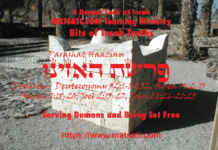This weeks reading is from Parashat Pekudei (Shemot / Exodus 38:21-40:38), the parashah title Pekudei (פְקוּדֵי) means “amounts of,” and is the first distinctive word, in the portion. Parashat Pekudei is the 23rd weekly Torah portion and the 11th and last portion in the book of Shemot / Exodus. The Scriptures detail the materials for the Tabernacle (38:21-31) and lists the construction of the priestly garments (39:1-43). Shemot / Exodus 40:1-33 describes how the tabernacle was Erected after the various parts were constructed. The last paragraph of the book of Exodus, and of the Torah portion describes the glory of the Lord descending upon the Tabernacle (40:34-38).
ספר שמות פרק מ
לד ויכס הענן את אהל מועד וכבוד יהוה מלא את המשכן: לה ולא יכל משה לבוא אל אהל מועד כי שכן עליו הענן וכבוד יהוה מלא את המשכן: לו ובהעלות הענן מעל המשכן יסעו בני ישראל בכל מסעיהם: לז ואם לא יעלה הענן ולא יסעו עד יום העלתו: לח כי ענן יהוה על המשכן יומם ואש תהיה לילה בו לעיני כל בית ישראל בכל מסעיהםתרגום אונקלוס
לח אְרֵי עְנַן יְקָרא דַיוי מַטַ עַל מַשכְנָא בִימָמָא וְחֵיזוּ אִישָתָא הָוֵי תהי בְלֵיליָא בֵיה לְעֵינֵי כֹל בֵית יִשרָאֵל בְכֹל מַטְלָנֵיהוֹן׃תרגום יונתן בן עוזיאל
לח ארום ענן יקרא דייי הוה מטלל על משכנא ביממא ועמודא דאישתא הוה מנהר בליליא וחמיין כל בני ישראל בכל מטלניהוןShemot / Exodus 40:34-38
40:34 Then the cloud covered the tent of meeting, and the glory of the Lord filled the tabernacle. 40:35 Moses was not able to enter the tent of meeting because the cloud had settled on it, and the glory of the Lord filled the tabernacle. 40:36 Throughout all their journeys whenever the cloud was taken up from over the tabernacle, the sons of Israel would set out; 40:37 but if the cloud was not taken up, then they did not set out until the day when it was taken up. 40:38 For throughout all their journeys, the cloud of the Lord was on the tabernacle by day, and there was fire in it by night, in the sight of all the house of Israel. (NASB)Targum Onkelos
40:38 For the Cloud of the Glory of the Lord was upon the tabernacle by day, and the vision of fire was in it by night, in the eyes of all the house of Israel in all their journeys.Targum Pseudo Jonathan
40:38 For the Cloud of the Glory of the Lord overspread the tabernacle by day, and (as) a column of fire it gave light in the night, that all the sons of Israel might see in all their journeys. [JERUSALEM. Because the Cloud of the Glory of the Lord’s Shekinah overspread the tabernacle by day, and a fire shined upon it all the nights; all the sons of Israel seeing in all their journeys.]
The LORD commanded Moshe to assemble the Mishkan on the first month in the second year from the day that He brought them out of Egypt with a mighty hand. The Scriptures say in Shemot / Exodus 40:2 ב בְּיוֹם-הַחֹדֶשׁ הָרִאשׁוֹן בְּאֶחָד לַחֹדֶשׁ תָּקִים אֶת-מִשְׁכַּן אֹהֶל מוֹעֵד: 40:2 ‘On the first day of the first month you shall set up the tabernacle of the tent of meeting. (NASB) Note how the Hebrew text says “beYom haChodesh haRishon” (בְּיוֹם-הַחֹדֶשׁ הָרִאשׁוֹן) “in the day of the first month.” Note that “Chodesh ha-Rishon” (חדֶשׁ הָרִאשׁוֹן), “the first month,” is named this way and the other months are named in relation to it. This is similar to the days of the week in the Hebrew calendar (i.e., the first day, the second day, etc.). Note also that Ramban (Nachmanides) wrote “By counting every month from Nisan, we constantly commemorate the miracle that God performed when He took us out of slavery.” This is the most frequent designation of this month in Scripture. The reference here in Shemot / Exodus 40:2 is referring to the month of Nissan. In the Scriptures we also read about “Rosh Chodashim” (ראשׁ חֳדָשִׁים), the “head of the months.” This also is the month of Nisan and this is written this way for the purpose of counting the days, months, and holidays of the Hebrew calendar. In the Torah, we also read that Moshe gave the commandment to begin building the Tabernacle (see Shemot / Exodus 25:8) including listing all of the building materials in Parashat Terumah (Shemot / Exodus 25:1-27:19). Note however that the Lord told Moshe to construct a Tabernacle prior to the sin of the golden calf in Parashat Ki Tisa (Shemot / Exodus 30:11-34:35) but it is believed that the command Moshe gave to the children of Israel of the actual construction of the tabernacle was on the day after Yom Kippur (i.e., the month of Tishri 11) which is a time known as “Simchat Torah” (שִׂמְחַת תּוֹרָה) “the joy of Torah” because Moshe gone up on the mountain in an attempt to atone for all of Israel drawing a parallel to Yom Kippur (the Day of Atonement). Based upon this analysis of the Scriptures, this implies that it took less than six months for Betzalel and Oholiab to create the Tabernacle and all its furnishings. Note also that the Tabernacle was consecrated for seven days before the Lord manifested His Presence there. Moses then anointed all its components with the sacred anointing oil called “shemen ha-mishchah” and it is interesting to note that the word “mishchah” (מִשְׁחָה) comes from the same root as “Messiah” (מָשִׁיחַ), suggesting that the Mishkan (Tabernacle) would foreshadow God’s plan of redemption given in Yeshua the Messiah. Aaron and his sons were dedicated to operate as priests to make atonement for the people. Following these things, the Divine Presence of God manifest as the Shekhinah (the Cloud of Glory) and filled the Holy of Holies in the Tent of Meeting and as our Scripture reading states the cloud covered the Tabernacle by day and was as fire by night. The Aramaic Targumim translate Shemot / Exodus 40:38 to say 40:38 For the Cloud of the Glory of the Lord overspread the tabernacle by day, and (as) a column of fire it gave light in the night, that all the sons of Israel might see in all their journeys. (Aramaic) This translation is significant here at the end of the book of Exodus. The light of the Lord is what gives one direction even in the darkest of times (night). The people had their eyes and focus upon the Tabernacle, because the Scriptures say that the people saw the cloud by day and the fire by night indicating that their attention was directed toward this dwelling place of God, the Tabernacle. These scriptures should speak to our hearts, to look towards the tabernacle that God has created, in His specific Time, Place, and Design, the Tabernacle of His Word (John 1:14), Yeshua the Messiah and Savior of all the world! Praise the Lord! BTT_Parashat Pekudei-2014








